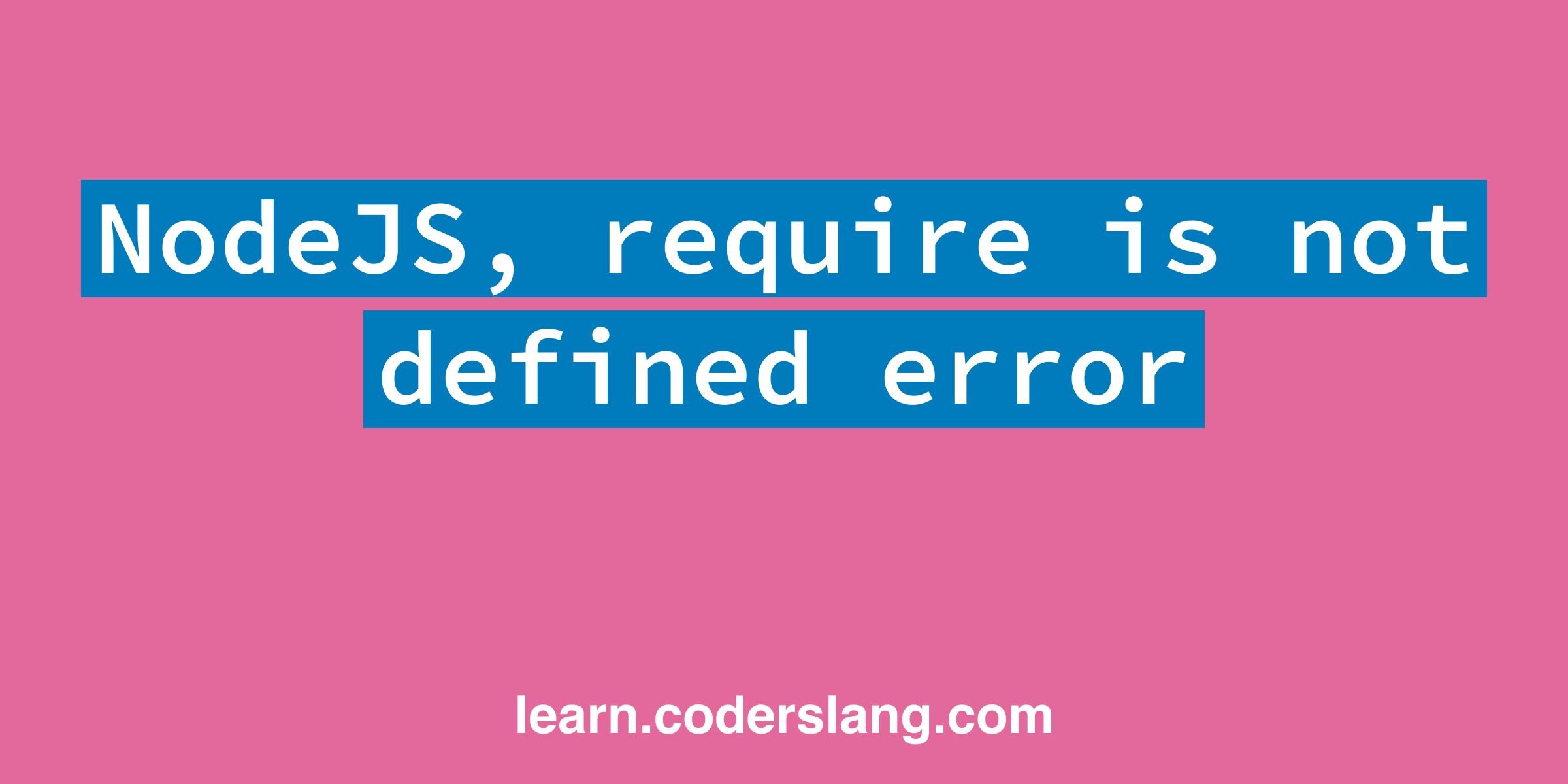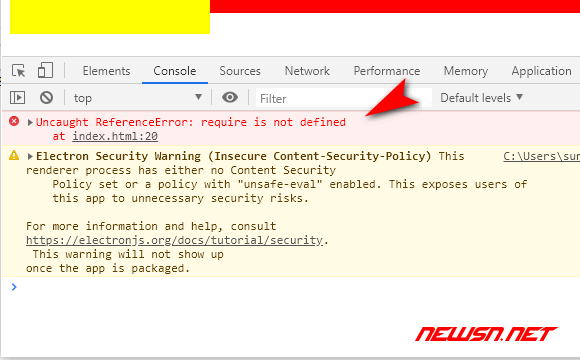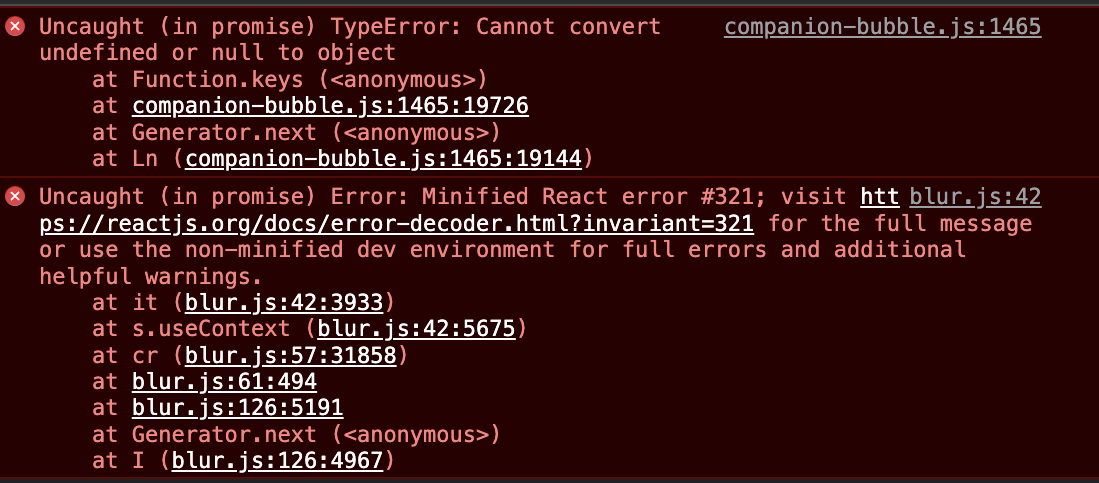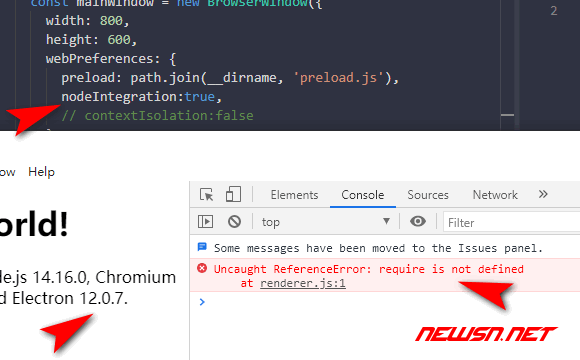Uncaught Referenceerror Require Is Not Defined
Introduction (words: 152)
In the world of web development, encountering errors is a common occurrence. One such error that developers often come across is the “Uncaught ReferenceError: Require is Not Defined.” This error can be frustrating and challenging to debug, especially for those new to JavaScript and module systems. In this article, we will explore what the error means, its causes, common scenarios in which it occurs, and various approaches to resolving it. By understanding this error thoroughly, developers can save time and effort in troubleshooting and ensure the smooth execution of their code.
What is the “Uncaught ReferenceError: Require is Not Defined” Error? (words: 216)
The “Uncaught ReferenceError: Require is Not Defined” error typically occurs when using JavaScript module systems such as CommonJS or AMD (Asynchronous Module Definition) and when the required module or dependency cannot be found. The error message indicates that the “require” function, responsible for importing modules, is not recognized or defined.
Causes of the “Uncaught ReferenceError: Require is Not Defined” Error (words: 254)
Several factors can contribute to this error. The most common causes include:
1. Missing Module Loader: If a module loader like RequireJS is not properly included in the project, the “require” function will not be recognized, resulting in the error.
2. Incorrect Script Order: When scripts are not loaded in the correct order, the module dependency chain can become broken, leading to the error message.
3. Misconfigured ES Module Syntax: When working with ECMAScript (ES) modules, using the incorrect syntax or incorrectly configuring modules can cause the error.
Common Scenarios in Which the “Uncaught ReferenceError: Require is Not Defined” Error Occurs (words: 319)
This error can manifest in various scenarios, including but not limited to:
1. Node.js Environments: When utilizing Node.js, developers commonly encounter this error if the required packages or modules are not installed correctly or if the “require” function is used outside the scope of Node.js modules.
2. Front-end Development: In front-end development, this error typically occurs when using a module system like RequireJS, where the proper configuration is essential for modules to be recognized and loaded correctly.
3. ECMAScript (ES) Modules: When working with ES modules, if the code references “require” instead of “import” or uses the wrong syntax, this error can arise. Additionally, this error might occur in Laravel applications using Vite, a build tool that supports ES modules.
Resolving the “Uncaught ReferenceError: Require is Not Defined” Error (words: 218)
To resolve this error, several approaches can be employed.
1. Using a Bundler or Module Loader (words: 141)
Utilize a bundler or module loader like Webpack, Browserify, or RequireJS to handle module imports and ensure that the “require” function is recognized by the environment.
2. Checking the Script Order and Dependencies (words: 178)
Ensure that scripts are loaded in the correct order and that all dependencies are correctly specified. This can help maintain the correct module dependency chain and prevent the error.
Troubleshooting and Debugging the “Uncaught ReferenceError: Require is Not Defined” Error (words: 185)
To effectively troubleshoot this error, consider the following steps:
1. Confirm the Installation of Required Packages (words: 127)
Ensure that all required packages or dependencies are correctly installed in the project.
2. Validate the Module Loader (words: 127)
Double-check that the chosen module loader, such as RequireJS, is correctly configured and included in the project.
3. Verify the Syntax and Usage of Modules (words: 138)
If working with ES modules, review the syntax and ensure that “require” is not mistakenly used instead of “import” or proper module syntax.
Conclusion (words: 97)
The “Uncaught ReferenceError: Require is Not Defined” error can be daunting, but with a thorough understanding of its causes and appropriate troubleshooting techniques, developers can effectively resolve it. By using module loaders, checking script dependencies, and validating the module syntax, this error can be overcome. Remember that debugging is an essential part of the development process, and error resolution enhances the efficiency of building robust web applications.
FAQs:
Q1. What does “Require is not defined” mean?
The “Require is not defined” error occurs when the “require” function, responsible for importing modules, cannot be found or recognized in the current environment or scope of the code.
Q2. How can I fix the “Require is not defined” error in Node.js?
Ensure that the required packages or modules are correctly installed using the Node Package Manager (npm). Additionally, confirm that the code using “require” is located within the proper scope of Node.js modules.
Q3. What does “Cannot use import statement outside a module” mean?
This error refers to the usage of the “import” statement, which is specific to ECMAScript (ES) modules, outside of the recognized module scope. Make sure your codebase is correctly configured for ES module usage.
Q4. Can I use “import” instead of “require” to fix the error?
Yes, if you are working with ECMAScript (ES) modules, you should use the “import” statement instead of the “require” function. Make sure to update your code and ensure the proper module syntax is followed.
Q5. How can I resolve the “Require is not defined” error in Laravel applications using Vite?
To fix this error while using Vite, you can migration from the CommonJS module syntax to ECMAScript (ES) modules by updating your codebase and Vue files. Make sure to follow the proper ES module syntax and utilize the “import” statement instead of “require.”
How To Fix \”Uncaught Referenceerror: X Is Not Defined\” In Javascript
What Is Require Not Defined In Javascript?
JavaScript is a versatile programming language that has become essential for web development. One of the most common error messages that developers encounter is “require is not defined.” This error occurs when using the require function, which is a crucial part of JavaScript modules used to import functionality from other files or libraries. In this article, we will explore in-depth what this error means, why it occurs, and how to fix it.
Understanding the require function
Before we delve into the “require is not defined” error, it’s important to understand the require function and its purpose. In JavaScript, the require function is primarily used to include external modules or files to access their functionality. This function is particularly useful when organizing code into smaller, reusable components.
Why does the error occur?
The “require is not defined” error occurs when the require function is used in an environment that does not support it. The require function is not native to JavaScript and is typically provided by module loaders or bundlers like Node.js or webpack. These tools enable JavaScript to use modules, which in turn help manage dependencies and improve code organization.
If you encounter the “require is not defined” error, it usually means that the necessary environment or module loader is not set up correctly. It could also mean that the required module is missing or has not been installed.
Fixing the “require is not defined” error
To fix the “require is not defined” error, you need to ensure that the require function is available in your current environment. Here are a few potential solutions:
1. Verify your environment: If you are working with JavaScript on the web browser, it’s important to note that the require function is not native to browsers. To use the require function in a browser environment, you need to include a module bundler like webpack or use a library like RequireJS that provides this functionality.
2. Use a module bundler: If you are working with Node.js, you will have access to the built-in require function. However, if you are using external libraries or modules, it is recommended to use a module bundler like webpack. Webpack bundles your JavaScript code and its dependencies into a single file, allowing you to use the require function effortlessly.
3. Install missing dependencies: If the required module or library has not been installed, you will encounter the “require is not defined” error. Ensure that you have installed all the necessary dependencies using a package manager like npm. Once installed, you can use the require function to import the module successfully.
4. Check file paths: Sometimes, the “require is not defined” error indicates that the required file or module cannot be found. Double-check the file paths and ensure they are correct. The require function relies on accurate paths to locate the desired module or file.
Frequently Asked Questions (FAQs)
1. Can I use the require function in the browser without a bundler?
Most modern browsers do not natively support the require function. However, you can use library loaders like RequireJS or module bundlers like webpack to use the require function in a browser environment.
2. Is the “require is not defined” error specific to a particular JavaScript framework?
No, the error is not framework-specific. It can occur in any JavaScript environment where the require function is not available or set up correctly.
3. What is the alternative to the require function?
The import statement, supported in modern JavaScript versions (ES6 and above), is an alternative to the require function. The import statement allows for the import of modules and functionality in a more standardized and intuitive way.
4. Can I use the require function without a bundler in Node.js?
Yes, Node.js provides the require function natively, allowing you to import modules without the need for a bundler. However, using a bundler like webpack can still enhance your development process by optimizing, bundling, and managing dependencies more efficiently.
In conclusion, the “require is not defined” error is a common stumbling block for JavaScript developers. It signals that the require function is not available in the current environment or has not been set up correctly. By ensuring the correct environment, using module bundlers, installing dependencies, and double-checking file paths, you can overcome this error and make full use of the require function to import modules with ease.
Why Is Require Not Working In Javascript?
JavaScript is a versatile programming language that allows developers to build interactive web applications. One of the key features of JavaScript is its ability to import and use external libraries or modules. The `require` function is commonly used to load these modules. However, there are instances where the `require` function may fail to work as expected. In this article, we will explore the reasons behind this issue and discuss possible solutions.
What is `require` in JavaScript?
Before delving into the “why,” let’s understand the essence of `require` in JavaScript. `require` is a built-in function in Node.js, a runtime environment for executing JavaScript code outside of a browser. It is primarily used to import external modules or libraries in a Node.js application.
In Node.js, the use of `require` is straightforward. However, when JavaScript is executed in the browser, `require` is not natively available. Instead, developers rely on bundlers such as Webpack or module loaders like RequireJS to emulate the behavior of `require` in the browser. These bundlers and loaders provide a way to manage dependencies and ensure proper loading of modules in a web application.
Reasons why `require` may not work:
1. Incorrect module bundler configuration: The most common reason for `require` not working is an incorrect configuration of the module bundler. Each bundler has its own specific configuration, and errors can occur if the configuration is not properly set up. For example, if using Webpack, you need to ensure that you have defined the correct entry point and configured the relevant loaders to handle different file types.
2. Missing or outdated dependencies: Another reason for `require` not working is missing or outdated dependencies. When using `require`, it is essential to have the required dependencies properly installed. If a dependency is missing or not up to date, the module may not load correctly, leading to errors. Checking the package.json file and running the appropriate package manager commands (e.g., `npm install`) can help resolve this issue.
3. File location and path issues: One common mistake that can cause `require` to fail is incorrect file locations or paths. When using `require`, it is crucial to provide the correct relative path to the module you want to import. Failure to do so can result in the module not being found, leading to errors. Double-checking the file path and ensuring that the module file is in the specified location can often resolve this problem.
4. Conflicts between module loaders: If you are using different module loaders or bundlers simultaneously, conflicts may arise. For instance, if you are using both Webpack and RequireJS in the same project, they may clash and cause issues with the `require` function. In such cases, it is recommended to choose a single module loader or bundler to avoid conflicts. You may need to reconfigure your project accordingly.
5. Syntax or coding errors: As with any programming language, syntax and coding errors can prevent `require` from working correctly. Small mistakes, like missing semicolons or incorrect function calls, can lead to unexpected behavior. It is crucial to review your code carefully, use linters or IDEs with error detection features, and debug any errors to ensure proper functionality of the `require` function.
FAQs:
Q1: Is `require` supported in all browsers?
A1: No, `require` is not natively supported in all browsers. It is primarily used in Node.js environments. However, with the help of module bundlers like Webpack or loaders like RequireJS, it can be emulated in the browser as well.
Q2: I’m using Webpack, but `require` still doesn’t work. What could be the issue?
A2: There may be various reasons why `require` is not working with Webpack. First, verify that you have correctly set up your configuration file (webpack.config.js). Check the entry points and module loaders for potential errors. Additionally, ensure that your dependencies are installed correctly and are up to date.
Q3: I checked the configuration, installed dependencies, and verified the file path, but `require` still fails. What else can I do?
A3: If you have exhausted the common fixes, it is advisable to investigate if there are any conflicts between different module loaders or bundlers in your project. Double-check your project’s setup and consider using a single module loader or bundler rather than multiple conflicting ones.
Q4: Are there any alternative solutions to `require` in JavaScript?
A4: Yes, there are alternative solutions like `import` and `export` statements introduced in ES6 (ECMAScript 2015). These statements provide a standardized way to load and share modules between files. However, using `import` and `export` requires transpiling or the use of modern browsers that support ES6 modules.
In conclusion, `require` may not work in JavaScript due to various reasons such as incorrect bundler configuration, missing dependencies, file location issues, conflicts between module loaders, or coding errors. It is crucial to investigate each potential cause and apply the necessary fixes accordingly. By understanding the possible obstacles and adopting best practices, developers can address `require` issues and ensure smooth module loading in their JavaScript applications.
Keywords searched by users: uncaught referenceerror require is not defined Require is not defined, Require is not defined nodejs, Cannot use import statement outside a module, RequireJS, Require is not defined in ES module scope, Uncaught ReferenceError require is not defined laravel, require is not defined in es module scope, you can use import instead, Uncaught referenceerror require is not defined Laravel vite
Categories: Top 24 Uncaught Referenceerror Require Is Not Defined
See more here: nhanvietluanvan.com
Require Is Not Defined
Introduction (65 words):
In the realm of JavaScript programming, encountering the error message “Require is not defined” can be perplexing, especially for beginners. It often leads to frustration and confusion, hindering the development process. In this article, we will delve into the root causes of this error and explore various scenarios where it occurs. Through a thorough analysis, we aim to demystify this common JavaScript error and provide effective solutions.
Understanding the Error (150 words):
The error message “Require is not defined” typically occurs when developers attempt to use the require() function in JavaScript, commonly found in Node.js projects. This function is used to import external modules or libraries into the current codebase, enabli’st developers to leverage pre-existing functionality.
However, require() is not native to JavaScript itself, but rather specific to certain environments, such as Node.js, where it is implemented by the CommonJS module system. Therefore, attempting to use this function outside of compatible environments will result in the “Require is not defined” error.
Common Causes (250 words):
1. Running JavaScript code in a web browser: Browsers do not inherently support the require() function. Instead, they rely on another module-loading feature, such as ECMAScript Modules (ESM) or the Asynchronous Module Definition (AMD). Using require() in a browser environment will trigger the error.
2. Incorrect setup or absence of Node.js: Node.js is a popular runtime environment for executing JavaScript on servers. When writing JavaScript code for Node.js, the require() function can be utilized. However, if Node.js is not installed or set up improperly, the “Require is not defined” error will arise.
3. Missing required modules: This error can also occur when developers neglect to install or include the required modules/packages for their project. It is crucial to check for any missing dependencies that cause the require() function to fail to load.
4. Syntax or spelling errors: Another common cause of this error is typing mistakes. Small syntax errors, such as incorrectly capitalizing require() as Require(), or misspelling the module name, can prevent the function from being recognized, generating the error message.
Solutions and Workarounds (380 words):
1. For web browser environments: When working in a browser, using require() will not suffice. Instead, consider using alternatives like ECMAScript Modules (ESM) or the Asynchronous Module Definition (AMD). ESM is natively supported in modern browsers, while AMD requires the use of a specific library like RequireJS.
2. Setting up Node.js correctly: If you intend to use the require() function within a Node.js environment, ensure that you have installed Node.js correctly. Verify that it is up-to-date and functioning properly by running a simple test script that utilizes require().
3. Installing missing modules: If you are missing required modules for your project, use package managers such as npm or yarn to install them. Review your project’s “package.json” file to verify all dependencies are listed correctly.
4. Check for syntax and spelling errors: Carefully inspect your code for any syntax or spelling mistakes that may be causing the error. Ensure that require() is correctly spelled and formatted with lowercase letters, and double-check the spelling and case sensitivity of the module names.
Frequently Asked Questions (FAQs):
Q1: Can require() be used in any programming language?
A1: No, require() is specific to JavaScript and certain environments like Node.js.
Q2: Why does require() work in Node.js but not in browsers?
A2: Node.js utilizes the CommonJS module system, which provides native support for require(). Browsers, on the other hand, rely on alternative module-loading features like ESM or AMD.
Q3: How can I use require() in a web browser environment?
A3: Instead of using require(), consider utilizing ESM (ECMAScript Modules) or AMD (Asynchronous Module Definition) libraries to achieve module loading in browsers.
Q4: I’ve installed Node.js correctly, but still encounter the error. What could be the issue?
A4: Verify that the required modules are properly installed and referenced in your project. Check for any typos or case sensitivity mismatches in your code.
Q5: Are there any alternative functions to require()?
A5: Yes, different environments and frameworks offer their own mechanisms for module loading, such as import statements (ES6 Modules) in modern JavaScript or specific libraries like requirejs.
Conclusion (95 words):
Encountering the “Require is not defined” error can be frustrating, but by understanding its root causes and implementing the appropriate solutions, developers can overcome this hurdle. Remember to utilize the require() function in the correct environment, check for module installations, and be vigilant regarding syntax and spelling errors. By following these guidelines and ensuring proper setup, developers can successfully integrate external modules into their JavaScript projects, expanding their capabilities and streamlining development workflows.
Require Is Not Defined Nodejs
Node.js is a widely used JavaScript runtime environment that allows developers to execute server-side JavaScript code. While working with Node.js, you might come across an error message that says “Require is not defined.” This error occurs when the global object, require, is not recognized or available to your program. In this article, we will dive deep into the causes of this error and explore various methods to troubleshoot and resolve it.
Understanding the Error:
The error “Require is not defined” typically appears when you attempt to use the require function, which is used to import modules in Node.js. This function allows you to include external modules or files into your code to access their functionality.
Causes of “Require is not defined”:
1. Incorrect Configuration:
One common reason for this error is an incorrect configuration of your Node.js project. Ensure that you have a valid package.json file in your project’s root directory, as this file defines the project’s dependencies and configuration.
2. Using Require in the Browser:
The require function is not natively available in web browsers, as it is specific to Node.js. If you try to use the require function in an HTML file running in a browser, you will encounter the “Require is not defined” error. Remember that require is only available within the Node.js environment.
3. Wrong File Extension:
The require function expects the imported files to have the .js extension by default. If you are directly importing a file without specifying the extension, make sure that the file you are importing has the .js extension.
Troubleshooting Methods:
1. Installing missing dependencies:
If your project relies on external modules, ensure that you have installed them properly. Navigate to your project directory in the terminal and run the command `npm install` to install all the dependencies listed in your package.json file. This will ensure that the required modules are available for your program.
2. Confirming Node.js environment:
Double-check that you are running your code within the Node.js environment and not in a browser. The require function is not available in browsers by default, so attempting to run Node.js code directly in a browser will throw the “Require is not defined” error.
3. Validating package.json:
Check if your project has a valid package.json file in the root directory. Verify that the file is properly formatted and contains the necessary configuration, such as the “dependencies” section. If the file is missing or corrupt, create a new package.json file using the `npm init` command.
4. Resolving File Extension Mismatch:
Ensure that the file you are trying to import using the require function has the correct .js extension. If you are importing a file without specifying the extension, make sure the file itself has the .js extension. You can also explicitly mention the file extension while using the require function like `require(‘./filename.js’);` to avoid any ambiguity.
FAQs:
Q1. What is the purpose of the require function in Node.js?
A1. The require function in Node.js allows you to include external modules or files into your code, enabling access to their functionality.
Q2. Can I use the require function in a web browser?
A2. No, the require function is specific to Node.js and is not natively available in web browsers. Using require in a browser will result in the “Require is not defined” error.
Q3. What should I do if my package.json file is missing or corrupt?
A3. If your project’s package.json file is missing or corrupt, you can create a new one by running the `npm init` command in your project’s root directory. This will guide you through setting up a new package.json file.
Q4. Can I use alternative methods to import modules in Node.js?
A4. Yes, there are alternative methods available such as using ECMAScript modules (ESM) or using a bundler like webpack. However, these methods have their own syntax and requirements which might need additional configuration.
In conclusion, encountering the “Require is not defined” error in Node.js often indicates a misconfiguration or environment-related issue. By following the troubleshooting methods mentioned above, you should be able to resolve the error and successfully import modules in your Node.js projects. Remember to double-check your project’s setup, dependencies, and file extensions to ensure smooth execution of your code.
Images related to the topic uncaught referenceerror require is not defined

Found 36 images related to uncaught referenceerror require is not defined theme

























![ReferenceError: exports is not defined in TypeScript [Fixed] | bobbyhadz Referenceerror: Exports Is Not Defined In Typescript [Fixed] | Bobbyhadz](https://bobbyhadz.com/images/blog/typescript-uncaught-referenceerror-exports-is-not-defined/banner.webp)












Article link: uncaught referenceerror require is not defined.
Learn more about the topic uncaught referenceerror require is not defined.
- How to Fix ReferenceError: Require is Not Defined in JavaScript
- Browser: Uncaught ReferenceError: require is not defined
- ReferenceError: require is not defined in JavaScript – Stack Diary
- How to fix “require is not defined” in JavaScript / Node.js?
- ReferenceError: require is not defined in JavaScript [Fixed]
- ReferenceError: require is not defined in JavaScript – Stack Diary
- JavaScript fix ReferenceError: require is not defined – sebhastian
- RequireJS
- Use require() on client side – JavaScript – Research hubs
- JavaScript fix ReferenceError: require is not defined – sebhastian
- Fix “require is not defined” in JavaScript/Node – Stack Abuse
- How To Fix ReferenceError require is not defined in JavaScript
- How to fix require is not defined in JS – Weekend Projects
- Fix Uncaught ReferenceError: require is not defined … – LinuxPip
See more: https://nhanvietluanvan.com/luat-hoc